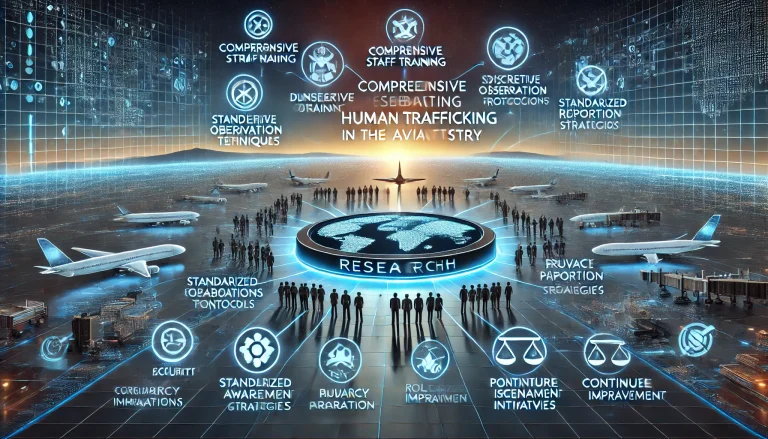Problem Statement
The aviation industry is highly dependent on public trust. Passengers entrust their lives to airlines every time they board a plane, making safety, reliability, and transparency critical to maintaining that trust. However, the industry faces significant challenges when it comes to public perception, particularly after high-profile accidents, controversies, or operational disruptions. In such instances, public confidence can be shaken, leading to decreased bookings, negative media coverage, and long-lasting damage to an airline’s reputation.
Maintaining trust in the aviation industry requires a multi-faceted approach that includes rigorous safety practices, effective communication strategies, and transparent operations. Consistent safety records are the foundation of public trust, but even with a strong safety track record, airlines must be prepared to navigate the complexities of media coverage and public relations. In today’s digital age, news of accidents or controversies spreads rapidly, often accompanied by speculation and misinformation, making it imperative for airlines to respond swiftly and accurately.
Transparency is key to managing public perception. Airlines must provide clear and honest communication during crises, ensuring that passengers, stakeholders, and the general public are informed about the situation, the steps being taken to address it, and what they can expect moving forward. Additionally, airlines need to proactively engage with the public through various channels, including social media, press releases, and direct communication with passengers, to reinforce their commitment to safety and reliability.
Addressing these challenges is essential not only for individual airlines but for the aviation industry as a whole. A single high-profile incident can have ripple effects across the industry, affecting public confidence in air travel more broadly. By prioritizing transparency, effective communication, and consistent safety records, airlines can build and maintain the trust of the traveling public, ensuring their long-term success in a competitive industry.
Pain Points
- Public Trust After Accidents: The challenge of rebuilding trust after high-profile accidents or safety incidents.
- Media Coverage: Navigating the complexities of media coverage that can amplify negative perceptions.
- Crisis Communication: The need for effective and timely communication during crises to maintain public confidence.
- Transparency Issues: Ensuring that communication is clear, honest, and transparent, particularly in difficult situations.
- Misinformation: Addressing the spread of misinformation or speculation that can damage an airline’s reputation.
- Social Media Impact: Managing the rapid spread of news and public reaction on social media platforms.
- Consistent Safety Records: The importance of maintaining and communicating consistent safety records to build trust.
- Public Relations Management: The challenge of managing public relations in a way that positively influences public perception.
- Long-Term Reputation Management: Ensuring that trust is maintained over the long term, beyond immediate crises.
- Industry-Wide Impact: Understanding that incidents involving one airline can affect public confidence in the entire industry.

Future Vision
Our platform envisions a future where airlines consistently maintain public trust through proactive communication, transparency, and a steadfast commitment to safety. To achieve this, the platform will support the development of comprehensive crisis communication strategies that airlines can deploy in the event of an accident or controversy. These strategies will include pre-prepared messaging, media training for executives, and protocols for engaging with the public and the media during a crisis.
The platform will also emphasize the importance of transparency in all airline operations. Airlines will be encouraged to adopt practices that ensure they are open and honest with passengers and stakeholders, particularly when it comes to safety records, operational disruptions, and any incidents that may affect public confidence. Regular updates on safety performance, customer satisfaction, and operational improvements will be shared through various channels, helping to build and maintain trust over time.
To address the impact of social media and the rapid spread of news, the platform will provide tools for monitoring public sentiment and responding to concerns in real-time. By engaging directly with passengers and the public on social media, airlines can counter misinformation, clarify facts, and demonstrate their commitment to passenger safety and satisfaction.
Public relations will be another key focus, with the platform offering resources for managing media relations, crafting positive narratives, and highlighting the airline’s strengths and successes. This proactive approach to public relations will help airlines shape their image in the eyes of the public, ensuring that they are perceived as trustworthy, reliable, and committed to the highest standards of safety.
By prioritizing these initiatives, our platform aims to help airlines build and maintain the trust of the traveling public, even in the face of challenges and crises. In doing so, the platform will contribute to the long-term success and resilience of the aviation industry.
Use Cases
- Crisis Communication Strategies: Developing comprehensive plans for effective communication during crises.
- Transparency Initiatives: Encouraging airlines to adopt transparent practices and share regular updates on safety and operations.
- Social Media Monitoring Tools: Providing tools to monitor public sentiment and respond to concerns in real-time.
- Media Relations Management: Offering resources for managing media interactions and shaping positive narratives.
- Proactive Public Relations: Crafting and promoting stories that highlight the airline’s strengths and successes.
- Safety Performance Reporting: Regularly updating passengers and stakeholders on safety records and operational improvements.
- Executive Media Training: Preparing airline executives to effectively communicate with the media during crises.
- Misinformation Countermeasures: Developing strategies to counter misinformation and clarify facts during incidents.
- Public Sentiment Analysis: Using AI and data analytics to gauge public perception and adjust communication strategies accordingly.
- Industry Collaboration: Working with industry stakeholders to ensure a unified approach to building public trust.
Target Users and Stakeholders
- User: Airline Executives, Public Relations Teams, Crisis Communication Specialists, and Media Relations Managers
- Age Group: 30-60 years
- Gender: M/F
- Usage Pattern: Regular usage for managing public perception, crisis communication, and media relations in the aviation industry
- Benefit: Enhanced public trust, effective crisis management, and improved communication strategies
- Stakeholders:
- Airlines: Companies responsible for maintaining public trust and ensuring transparent communication
- Regulatory Bodies: Agencies overseeing aviation safety and public communication standards
- Media Organizations: Outlets reporting on aviation incidents and influencing public perception
- Passengers: Individuals who rely on airlines to provide safe, reliable, and transparent services
- Public Relations Firms: Companies specializing in managing public perception and media relations for airlines
Key Competition
- Crisis24: Provides crisis management and communication services, including support for aviation incidents.
- Control Risks: Offers crisis communication and public relations management for industries, including aviation.
- Brunswick Group: Specializes in corporate communications, helping companies manage their reputation during crises.
- Edelman: A global PR firm that supports crisis communication and reputation management for various industries, including aviation.
- Finsbury Glover Hering: Offers strategic communication services with a focus on managing public perception and media relations.
Products/Services
- Crisis24 Communication Services: Crisis management and communication support for aviation incidents.
- Control Risks Crisis Management: Comprehensive crisis communication and public relations services.
- Brunswick Group Corporate Communications: Managing reputation and media relations during crises.
- Edelman Crisis Communication: Strategic communication and public relations services for aviation and other industries.
- Finsbury Glover Hering Strategic Communication: Public perception management and media relations services.
Active Startups
- Signal AI: Uses AI to monitor media coverage and public sentiment, helping companies respond to crises.
- Dataminr: Provides real-time alerts and insights based on media and public data to support crisis communication.
- CrisisGo: Develops communication tools for managing crises, including those in the aviation industry.
- Onclusive: Offers media monitoring and analytics tools to help companies manage their reputation and public relations.
- Brandwatch: Provides social media monitoring and sentiment analysis to support public perception management.
- Zignal Labs: Delivers real-time media monitoring and analysis for effective crisis communication.
- Sprinklr: Offers a unified platform for managing customer experience, including social media and crisis communication.
- Cision: Provides media monitoring, analysis, and communication tools to support public relations and crisis management.
- Meltwater: Offers media intelligence and social listening tools to help companies manage public perception and crises.
- RavenPack: Uses big data analytics to monitor media coverage and public sentiment, supporting crisis communication.
Ongoing Work in Related Areas
- Crisis Communication Research: Developing new strategies for effective communication during aviation crises.
- Media Monitoring Tools: Advancing AI and data analytics for real-time monitoring of media coverage and public sentiment.
- Transparency in Aviation: Promoting transparency in airline operations to build and maintain public trust.
- Public Relations Best Practices: Researching best practices for managing public perception and media relations in aviation.
- Social Media Engagement: Exploring new ways for airlines to engage with the public and manage their image on social media.
Recent Investment
- Signal AI: $50M in Series D funding led by Highland Europe, November 2020.
- Dataminr: $475M in Series E funding led by Valor Equity Partners, March 2021.
- CrisisGo: $3.4M in Seed funding led by venture capital firms, June 2018.
- Brandwatch: $65M in Series D funding led by Partech, May 2018.
Market Maturity
The market for crisis communication and public perception management in aviation is rapidly maturing, driven by the increasing complexity of media coverage, the rise of social media, and the need for transparency in airline operations. Companies like Crisis24, Brunswick Group, and Edelman are leading the way with comprehensive crisis communication services, while startups like Signal AI, Dataminr, and Brandwatch are innovating with AI-driven tools for media monitoring and public sentiment analysis. Significant investments in crisis communication strategies, media monitoring tools, and public relations best practices are transforming the industry, enabling airlines to effectively manage public perception and maintain trust. As the market continues to evolve, we expect to see more integrated and proactive solutions that help airlines navigate the challenges of public perception in an increasingly complex media landscape.
Summary
The aviation industry frequently deals with issues related to public perception and trust, especially after high-profile accidents or controversies. Maintaining trust requires transparency, effective communication, and consistent safety records. Airlines must navigate the complexities of media coverage and public relations to ensure that they maintain a positive image and public confidence. Our proposed platform leverages crisis communication strategies, transparency initiatives, social media monitoring tools, and proactive public relations to address these challenges. Key pain points include rebuilding trust after accidents, managing media coverage, crisis communication, transparency issues, misinformation, social media impact, consistent safety records, public relations management, long-term reputation management, and industry-wide impact.
Target users include airline executives, public relations teams, crisis communication specialists, and media relations managers, with stakeholders encompassing airlines, regulatory bodies, media organizations, passengers, and public relations firms. Key competitors like Crisis24, Brunswick Group, and Edelman offer crisis communication and public relations services, while startups such as Signal AI, Dataminr, and Brandwatch are driving innovation in media monitoring and public sentiment analysis. Recent investments highlight significant interest and growth potential in platforms addressing public perception and trust in aviation.
By addressing these challenges and leveraging advanced technologies, our platform aims to help airlines build and maintain the trust of the traveling public, ensuring their long-term success and resilience in a competitive industry.



